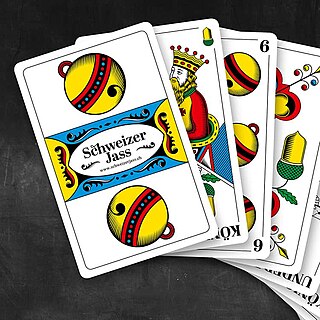
Jass is a trick taking, Ace-Ten card game and a distinctive branch of the Marriage family. It is popular throughout the Alemannic German-speaking area of Europe, as well as in Romansh-speaking Graubünden and the French-speaking area of Switzerland, German-speaking South Tyrol in Italy, and in a couple of places in Wisconsin, USA and Tuscarawas County, Ohio, USA.
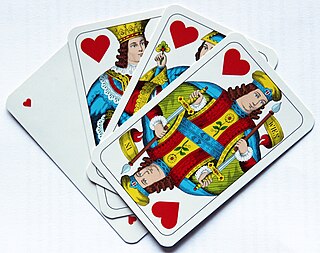
Préférence, frequently spelt Preference, is a Central and Eastern European 10-card plain-trick game with bidding, played by three players with a 32-card Piquet deck, and probably originating in early 19th century Austria, becoming the second most popular game in Vienna by 1980. It also took off in Russia where it was played by the higher echelons of society, the regional variant known as Preferans being still very popular in that country, while other variants are played from Lithuania to Greece.
Hucklebuck, also known as Huckly Buck and sometimes as Sputnik, is an American trick-taking card game of the Rams group for three to seven players. The game is native to the states of Nebraska and Iowa, although a variant called Huckley Buck is recorded in Nevada. The game appears to have arisen in the early 1900s in the Midwestern United States and may be based on Bourré, a Louisiana member of the Rams group. The rules given here are based on McLeod.

Bauerntarock also called Brixentaler Bauerntarock or Brixental Tarock, is a point-trick card game played in the Brixental, Austria. It may have originated in the 19th century either as an adaptation of 54-card Tapp Tarock onto the cheaper and smaller 36-card German pack. Another possibility is that it was adapted from the 78-card Grosstarock or Taroc l'Hombre game as the ratio of trumps to non-trumps is almost the same. It uses the Skat Schedule found in popular regional games such as Jass and Schafkopf. It is closely related to Bavarian Tarock, German Tarok, Württemberg Tarock and especially Dobbm. Like Bavarian Tarock and Tapp, Brixental Bauerntarock and Dobbm do not belong to the true tarot games, but have adopted rules from Tapp Tarock. The most fundamental difference between these games and true tarot games is in the use of German or French decks instead of true Tarot playing cards.

Dobbm or Tappen is a card game played in the Stubaital valley in Austria which, like Brixental Bauerntarock, Bavarian Tarock and Württemberg Tarock, is not a true Tarock game, but is one of a family of games derived from Grosstarock by adapting its rules to a regular, shortened pack of 36 cards. The ranking and point value of the cards in Dobbm is identical with those of the other variants mentioned. In Dobbm as well, one player always plays as a soloist against all the others. It most strongly resembles the Brixental variant: Dobbm is also played by four players, each player is dealt eight cards, four cards go to the talon and Hearts are the permanent trump suit. The fundamental difference between games of the German Tarok family and true tarot games is in the use of shortened German or French packs instead of true Tarot playing cards.

Dreierschnapsen, Talonschnapsen or Staperlschnapsen is a three-hand variant of the popular Austrian card game, Bauernschnapsen. The rules are very similar to those for Bauernschnapsen except that, instead of two teams of two players, one player bids to become the soloist against the other two who form a temporary alliance. Another difference is that the game makes use of a talon with which the soloist may exchange cards to improve his hand, hence its alternative name of Talonschnapsen. The game is usually played with William Tell cards.

Point Tarock was a three-player tarot card game, played mainly in Austria, which used the 54-card Industrie und Glück deck. It is probably extinct. Furr describes it as being "identical to Tapp but for the addition of a special announcement, allowing a Declarer to capitalize on a very good hand... spicing up the game considerably." Point Tarock is sometimes confused with its close cousin, Illustrated Tarock.

Droggn, sometimes called French Tarock is an extinct card game of the Tarock family for three players that was played in the Stubai valley in Tyrol, Austria until the 1980s. Droggn is originally local dialect for "to play Tarock", but it has become the proper name of this specific Tarock variant. An unusual feature of the game compared with other Tarock games is the use of a 66-card deck and that there is no record in the literature of a 66-card game and no current manufacturers of a such a deck. The structure of the game strongly indicates that it is descended from the later version of Tarok l'Hombre, a 78-card Tarock game popular in 19th-century Austria and Germany, but with the subsequent addition of two higher bids.

Zwicken is an old Austrian and German card game for 4 to 6 players, which is usually played for small stakes and makes a good party game. It is one of the Rams group of card games characterised by allowing players to drop out of the current game if they think they will be unable to win any tricks or a minimum number of tricks.
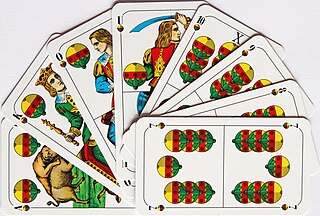
Bolachen is a traditional card game for 3 players that is played in Upper Bavaria. It is threatened by extinction.
Lampeln or Lampln is an old Bavarian and Austrian plain-trick card game that is still played in a few places today. It is one of the Rams group of card games characterised by allowing players to drop out of the current game if they think they will be unable to win any tricks or a minimum number of tricks.

Ramsen or Ramsch is a traditional Bavarian plain-trick, card game for three to five players that is played with a 32-card German-suited pack and is suitable both for adults and for children. It is one of the Rams group of card games that are distinguished by allowing players to drop out if they think they will fail to win the required number of tricks. An unusual feature of Ramsen is the presence of four permanent trump cards that rank just below the Trump Sow. It should not be confused with the contract of Ramsch in games like Skat or Schafkopf, nor with the related game of Rams which is also called Ramsen in Austria, but is played with a Piquet pack, does not have permanent trumps and has a different card ranking.
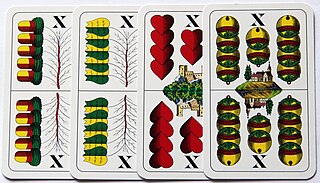
Matzlfangen is a traditional point-trick, card game for 4 players that originated in the Bavarian province of Upper Palatinate over 200 years ago and spread to Austria. It is still played in a few places today. The game is named after the Ten or Matzl, which plays a key role.
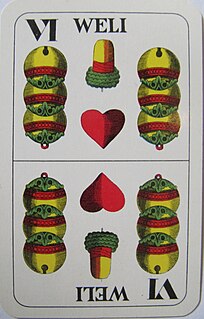
Mauscheln, also Maus or Vierblatt, is a gambling card game that resembles Tippen, which is commonly played in Germany and the countries of the old Austro-Hungarian Empire.

Schnalzen is an Austrian card game for 4 players and a member of the Rams group of games in which the key feature is that players may choose to drop out of the game if they believe their hand is not strong enough to take a minimum number of tricks. It is, broadly speaking, Ramsen with the Weli as the second-highest trump. Players are dealt 5 cards and may not exchange. The Weli is the second-highest trump and game is 20 points.

Kratzen is an Austrian card game for three to six players that is played for small stakes usually using a 33-card William Tell pack. It is a member of the Rams group of card games characterised by allowing players to drop out of the current game if they think they will be unable to win any tricks or a minimum number of tricks. The game is related to the Swiss Jass form, Chratze and has been described as "fun" to play.

Jaggln or Jaggeln is an historical Tyrolean card game designed for five players that used to be played purely as a winter pastime by farming folk. An unusual feature are its three highest trumps known as Jaggl, Zanggl and Buggl. The aim is to win the majority of gewisses – i.e. the four Sows, the four Tens and the Jaggl. So, for example, if a player holds all three top trumps, he is certain to win 3 tricks. And if, in doing so, he captures the four Sows, he has won because he has five of the nine gewisses.
Zwanzig ab, 20 ab or simply Zwanzig is card game for four players. It is a member of the Rams family in which the key feature is that players may choose to drop out of the game if they believe their hand is not strong enough to take a minimum number of tricks. It appears to be a recent, internet-propagated variant of Schnalzen or Bohemian Watten. However, the latter has a natural card ranking, is played with double German cards and a Weli, has no exchanging and has a different scoring system. It is suitable for children from 8 upwards. It may be related from Fünf dazu! which is a simpler game described by Gööck in 1967 that has neither trumps nor the option to drop out.

Sjavs is a Danish card game of the Schafkopf family that is played in two main variants. In Denmark, it is a 3-player game, played with a shortened pack of 20 cards; in the Faroe Islands, where it is very popular, it is a four-hand, partnership game using a standard Piquet pack of 32 cards.

1001 is a point-trick card game of German origin for two players that is similar to Sixty-Six. It is known in German as Tausendundeins and Tausendeins ("1001") or Kiautschou. The winner is the first to 1001 points, hence the name. Hülsemann describes the game as "one of the most stimulating for two players", one that must be played "fast and freely".














